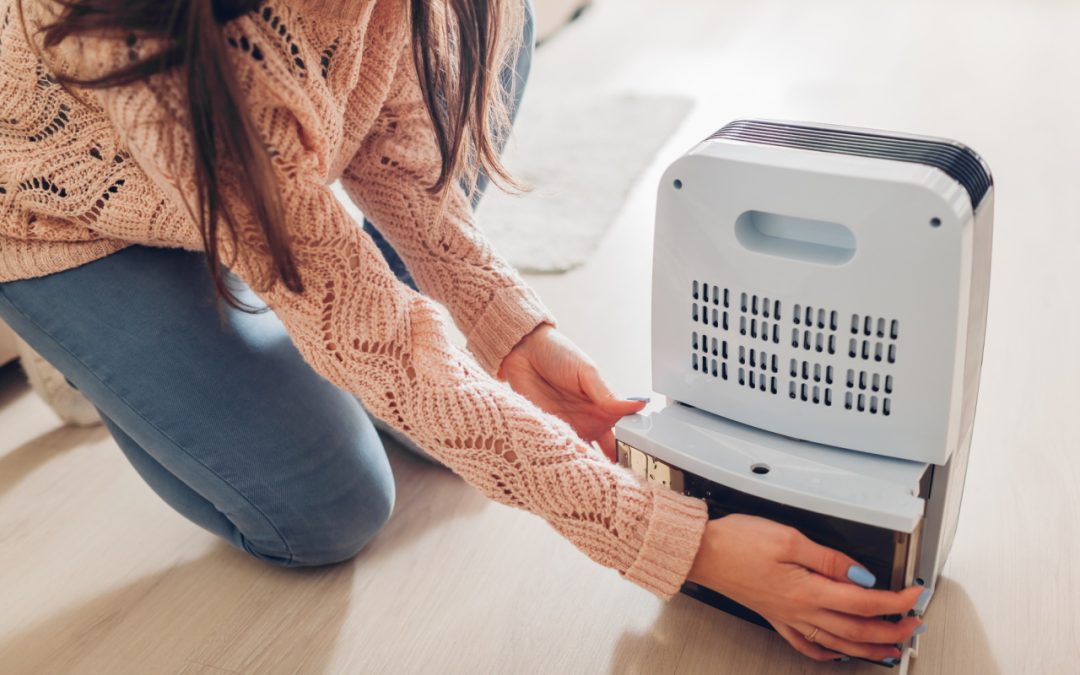High indoor humidity creates a breeding ground for mold, damages walls and paint, and invites unwelcome pests. Address these issues to maintain a comfortable and healthy living environment. Here are six ways to reduce indoor humidity and protect your living spaces from moisture-related problems.
Reduce Indoor Humidity
Dehumidify
Invest in a dehumidifier to control the humidity levels in your home. These appliances work by removing moisture from the air, helping prevent mold and mildew. Depending on the size of your home and the severity of the humidity problem, you can find a model for your needs. Choose a small portable unit for a single room or install a whole-house dehumidifier connected to the HVAC system.
Keep the Air Moving with Ceiling Fans
Ceiling fans help keep your living spaces cool during the summer and improve air circulation in your home. The enhanced airflow helps evaporate lingering moisture on surfaces, which, in turn, reduces humidity. Even in the cooler months, run the ceiling fans on a low setting to boost airflow and lower indoor humidity.
Use Exhaust Fans to Reduce Indoor Humidity
Use exhaust fans in rooms with high moisture, such as the bathroom and kitchen. The fans help expel humidity and odors directly outdoors, making them an excellent tool for controlling the moisture levels in these high-risk areas. Turn on the fan while cooking to pull odors and moisture out of the air. Use the ventilation fan when showering and allow it to run for 20 minutes after the shower to reduce humidity.
Address Leaks Promptly
Leaks from plumbing pipes and fixtures waste water and increase indoor humidity. Regularly check for and repair leaks to reduce moisture in your home. Plumbing maintenance aids in humidity control and can save you from costly repairs due to water damage.
Clean the Gutters
Blocked gutters allow water to seep beneath roofing materials and spill onto the walls of your house, increasing indoor humidity. Make a habit of cleaning your gutters regularly so rainwater can flow away from your home, reducing the chance of moisture leaking behind the siding.
Reduce Indoor Humidity: Let Fresh Air In
Sometimes, simple solutions are very effective. On sunny days, open the windows to improve circulation and allow moisture inside the house to escape. A breeze from outside is especially helpful in promoting evaporation and reducing humidity in the home.
These practical measures contribute to your home’s longevity and its inhabitants’ well-being. To combat the challenges of indoor moisture, embrace these tips to protect your property from water damage, mold, and pests. Take steps to create a less humid and more comfortable home and ensure a healthier living environment for you and your family.
FAQs
Are there safety concerns related to high indoor humidity?
Yes. Excessive moisture may lead to structural damage in homes, affecting walls, ceilings, and foundations. Moisture creates an environment conducive to mold growth, which can weaken structures and compromise safety. Electrical hazards increase when humidity causes corrosion or short circuits.
How does high indoor humidity impact energy bills?
Does high indoor humidity impact energy bills?
Absolutely. High indoor humidity can impact energy bills, as it forces air conditioning systems to work harder. When the air within a home is moist, it feels warmer than it is, prompting occupants to lower the thermostat increasing energy consumption. Air conditioners require extra effort to cool the air and remove excess moisture, which is energy-intensive.
Are there any long-term maintenance considerations homeowners should be aware of when implementing strategies to reduce indoor humidity?
Yes. Regularly clean your dehumidifiers and maintain good ventilation in areas prone to moisture. To protect your property, create an ongoing routine to manage humidity levels and create a safer, more comfortable living environment.
How does high indoor humidity affect the health of residents of your home?
High indoor humidity is a matter of discomfort and may affect the health of family members. Increased moisture levels create an environment where mold, mildew, and dust mites thrive. These irritants are known to provoke allergies and respiratory issues like asthma.
How frequently should homeowners inspect and clean their gutters to prevent moisture buildup and damage to the home’s interior?
Inspect and clean the gutters at least twice a year, typically in the fall and spring, to prevent moisture buildup that can lead to damage. More frequent cleanings may be necessary in regions with heavy rainfall or homes with overhanging foliage.
Advanced Termite and Home Inspections provides home inspections in Eastern NC. Contact us to schedule our services.

